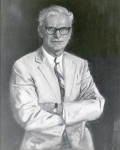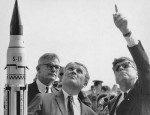The Unlikely Meeting Between Seventh-Graders and NASA Officialdom
by Philip Handleman
Spring was in the air. March winds swept across the northeastern Ohio flatlands carrying the balmy and aromatic scent of the thawing countryside. Incipient crocus and daffodils showed the tinctures of verdure in their annual ritual, penetrating the obdurate soil to enliven the tawny palette of our backyard gardens and herald the welcome sensation of new beginnings.
In 1963, America’s infatuation with the mythology of the Kennedy White House was in full swing. The Middle East oil embargo was a decade away; our car’s gas tank could be filled for less than five dollars. Domestic strife and a creeping foreign war drew heightened attention, yet the populace had room in its consciousness to keep tabs on the ambitious program that called for landing men on the moon.
At my junior high school, I and a couple seventh-grade classmates regularly spent our lunch hour on the roof peering at the moon through the lens of a telescope installed with National Science Foundation funds advanced in the aftermath of the launch of Sputnik in October 1957. A scant half-dozen years following that jolt, America was catching up to the Soviet Union in an all-out space race. The mesmerizing launches of Alan Shepherd, John Glenn and other Mercury Seven astronauts had already occurred.
The chunky, rabbit-eared televisions wheeled into our school system’s gyms so that assembled students could witness each of those liftoffs offered only static-laden, black-and-white imagery. It was enough, though, to spark a passion in young souls. Everyone I knew at school yearned to be an astronaut. The heavens beckoned and, like our space-suited heroes seen in grainy news clips, we were determined to join in the exploration of what the President had so aptly termed the New Frontier.
With the junior high’s Easter-time trip to the nation’s capital about to occur, my two buddies and I composed a letter to the Administrator of the National Aeronautics and Space Administration (NASA). We would be in Washington on our school trip and, as aspiring astronauts, we twelve-year-olds hoped to have a meeting with the agency’s head honcho. I don’t remember exactly how we worded it, but when the response came in an official NASA envelope, the chief of protocol wrote that if scheduling permitted on the day of our visit, the Administrator, James E. Webb, would gladly meet with us.
That knocked our socks off. We were so young and naïve that we didn’t know any limits, and our audacity was paying off. Come to think of it, we were kind of like NASA itself.
At last, the morning of our highly-anticipated NASA visit had arrived. My friends and I nervously entered the big rectangular office building in which the nation’s cutting-edge air and space endeavors were managed. In an instant we were unceremoniously lost in the bowels of the bureaucracy.
We knew that somewhere inside this labyrinth was the gentleman who had sent us the offer of a meeting. After scurrying up and down corridors and poking our curious heads into people’s offices, we were vectored to the right place. The chief of protocol was waiting for us and he didn’t waste any time.
Administrator Webb was testifying before Congress. So, much as he would have liked to meet us, the explanation went, his schedule made it unworkable. We were told that the next in line in the NASA hierarchy would have liked to meet us as well, but the Deputy Administrator, Hugh L. Dryden, had been admitted to the hospital. The grand old man of aeronautics, a towering figure in the field, was just too ill.

I was saddened and deflated; our visit might prove a bust. However, after a pause, we heard the positive news that the third-ranking official, Robert C. Seamans, Jr., was available. I will never forget the next words: “Dr. Seamans will see you now.”
We walked down another corridor and turned into a suite of offices. We passed a secretary’s station and the door at the end was open. With rising trepidation, we walked in. There we stood, front and center before NASA’s Associate Administrator. Could this really be happening?
Seamans was impervious to our presence; he continued marking papers spread out on his desk with an intensity rivaling the greatest of surgeons engrossed in an intricate transplant operation. We could have stood there all day and the brilliant engineer/manager would have remained oblivious. The chief of protocol cleared his throat, the kind of fake cough geared expressly to gain one’s attention.
Nothing happened. It took a few more deeply-guttural hacks before the senior official’s concentration broke. As soon as Seamans looked up and realized he had three anxious seventh-graders staring at him, he rose, walked around his desk and greeted each of us with a hearty handshake. A warm smile softened the rigidity exuded by his horn-rimmed glasses.
He leaned towards us with folded arms when fielding our questions. That lent a relaxed genteelness that belied his reputation as a stern taskmaster, especially when program schedule delays threatened. After all, the manned lunar mission’s timeline before the end of the decade had been proclaimed in public and a fleeting six years remained on the clock.
For the next ten minutes it was as if the point man for so many consequential decisions on NASA’s pathway to the moon had no acute worry or pressing responsibility. The kids from Cleveland drew his undivided attention.

He graciously led us to conversation pieces strewn about his office starting with a scale replica of the Saturn IB, the stepping-stone booster for the later Saturn V that would hurtle brave space explorers farther than any humans had ever traveled. Then he showed us a glass-encased model of the lunar lander, an early version of the toy-like vehicle with spider legs that was designed to transport two of the Apollo crew to the lunar surface and back to their orbiting ship.
The visit was magical for there we were, old enough only to ride our bicycles yet dreaming of flights to other worlds, encouraged by a member of NASA’s famous “management triad,” the team of three leaders who guided the agency in what came to be viewed as its glory years.
Webb was the lawyer-statesman, a one-time Marine aviator who brought a wealth of managerial experience from his time at Sperry Gyroscope, the oil industry and the Bureau of the Budget. Dryden, a prodigy who entered Johns Hopkins at age fourteen, applied his genius to aerodynamics and headed NASA’s precursor, the National Advisory Committee for Aeronautics. Seamans was a Harvard engineering graduate who had earned his master’s degree in aeronautics at MIT and then a doctorate in instrumentation under the tutelage of MIT’s super-brainy Charles Stark Draper. Between his fledgling teaching career at MIT and his stint at NASA, Seamans had managed RCA’s Airborne Systems Laboratory.
Little did anyone know at the time that Seamans would rise further at NASA, serve as Secretary of the Air Force and crown his illustrious career as Dean of MIT’s School of Engineering. When word of his passing on June 28, 2008, just shy of his ninetieth birthday, rippled through the aerospace community, I harked back to our brief but inspiring meeting a half-century ago.That memory has become an internal spring and a resource to kindle a sense of new beginnings.
Likely explanations for Seamans’ commitment to mentorship of young people were evident in his 1996 memoir. At boarding school, he was required to spend several weekends digging ditches as punishment for an infraction of the rules. The school’s headmaster, who had meted out the penalty, came to dig alongside his chastened student. Seamans wrote that his headmaster “had an influence on my sense of values.” Indeed!
As an undergraduate, Seamans was inspired by a civil engineering professor who counseled him to consider aeronautical engineering rather than medicine, to which he had been leaning. Later, Professor Draper, the eminent MIT experimentalist, took Seamans under his wing and taught him how advanced mathematics can be a means to solving seemingly intractable problems.
Like his mentors, Seamans kept his office door open to star-gazing youth, which in my case made an impression that has lasted a lifetime. With each introductory plane ride I give to a young person, the chain of transference is exercised, potentially stirring the raw emotion of flight to enable the passing of the torch yet again to animate the next wave of dreamers. Those of us who fly are undeniably lifted on wings infused with the goodwill of others who cared enough to share the keys to the glorious kingdom of the sky.
EDITOR’S NOTE: Philip Handleman, the author or editor of twenty-two aviation books, has been a pilot of antique airplanes for many years. He resides in Birmingham, Michigan.